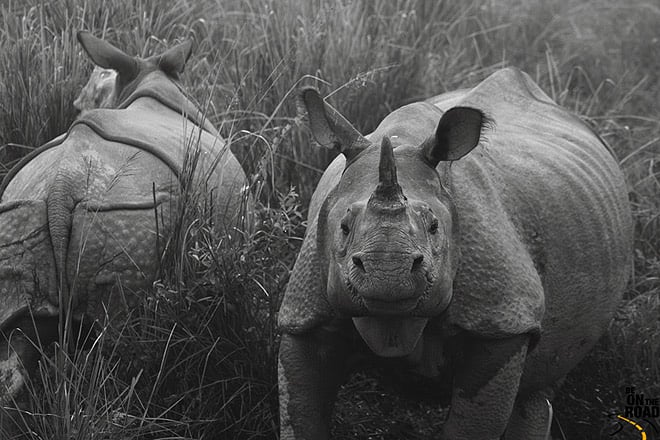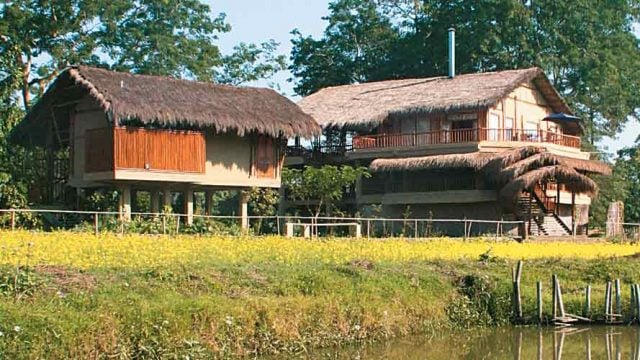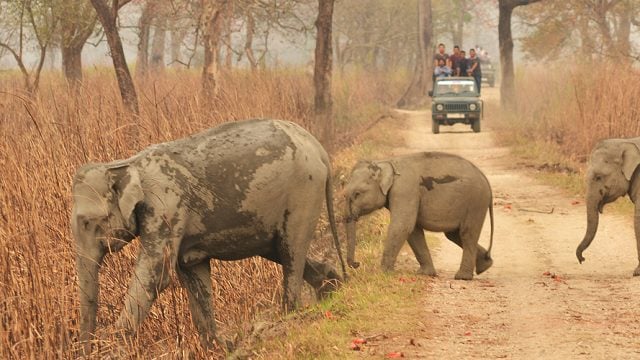Ranjit Barthakur and I sat on a large log watching otters fish in the Diphlu river. We
Across the river from where we now sat in silence, two rhinos made a quick appearance and then vanished into their veiled grassland world. They were followed by a small herd of elephants whose trumpeting we heard long before they revealed themselves. A decidedly fishy smell and silvery scales strewn about the log suggested we were not far from the underground otters’ holt. The whole of the Assam valley, the whole world was once this ordered, this peaceful, I thought to myself as I savoured the moment.
While Kaziranga had been set aside for rhinos, the mantle of protection ended up benefiting tigers too—this is the world’s densest tiger-populated habitat, with one tiger per 17 sq km. Kaziranga also supports around 1,000 Asian elephants, 1,600 great Indian one-horned rhinos, 1,400 wild buffalo, and 500 swamp deer. The park literally bursts with life.
On an earlier trip we had got fleeting glimpses of one of Kaziranga’s over 90 wild tigers and marvelled at the manner in which nature was able to administer itself. We had also driven towards Tezpur, rowed out to a sand island in the Brahmaputra river, and watched blind freshwater dolphins hunt fish.

I have travelled the length and breadth of India over the past three decades and have barely scratched the surface of what this country has to offer. I love Tadoba in Maharashtra and Ranthambhore in Rajasthan where I have seen most of my tigers, for instance. Nothing, nothing can describe the rush of adrenaline which courses through the system on seeing a wild tiger—quiet, confident, supercilious, perfect. But admiration cannot be the motivation to save a species. My life is therefore dedicated to visiting lesser known destinations and some of the fragile corridors connecting the best known forests—Kanha to Bandhavgarh and Corbett to Rajaji—to document their worth and to communicate a simple truth to my fellow citizens—unless we protect wild nature we have a bleak, waterless, future ahead of us.
India is many countries rolled up in one. From the high Himalaya to the rainforests of the northeast, and from the central Indian forests made famous by Kipling to the coral wonderland of the Andamans, you could travel an entire month without repeating a single wild experience.

I recall walking in the forests between Goa and Karnataka to explore a cave that is home to the world’s last living Wroughton’s free-tailed bats. The deciduous forests were also home to both tiger and elephant and when I tired I stopped by a cold river in which I was able to swim and drink water. Above me in the canopy, warblers were busy hunting, preparing to put on fat for the long journey home to the Himalaya. With birdsong in the air, cold clean water in our rivers, and secret caves to explore there was little else I could ask for from the earth.
Each year now I go out into the wilds in search of such experiences, far from the tourist traps that many of our most popular wildlife destinations have become. One such trip saw me aboard a Coast Guard vessel in the Andaman and Nicobar Islands where diving amidst the coral wonderland I found myself face to face with over 100 spinner dolphins that seemed even more curious about us than we were about them. Wildlife experiences are to be had almost everywhere in India, provided one is gifted with a touch of adventure and the ability to take joy from wild nature rather than the urban creature comforts that are on offer in the best-known destinations.
Ranthambhore National Park
Tadoba Tiger Reserve
Wildlife in India
Leave a Reply
You must be logged in to post a comment.





